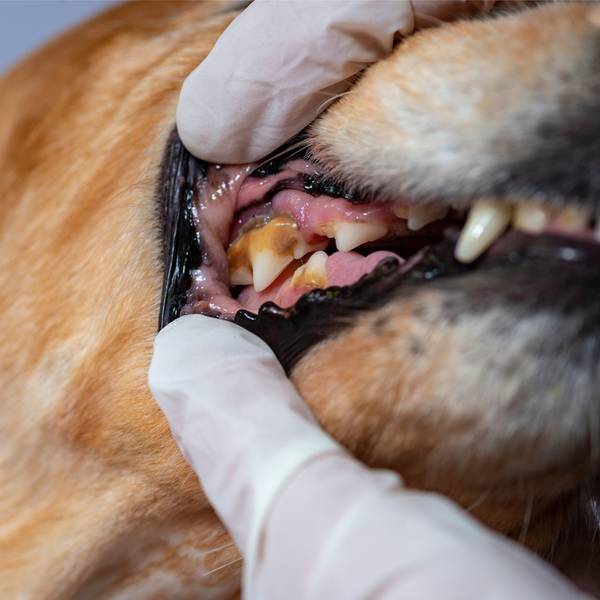Dental disease is a term used to describe a group of dental afflictions which contribute to poor health.
It is by far the most common health problem experienced by pets, especially by age three and up.
A tale of two case studies
Boscoe, a 7-year-old Bull Arab, had everything. Engaging pet parents, a pool for hot days, yummy food and bones, and a cosy bed to sleep. Boscoe, unfortunately, also had very bad breath. Over time, his breath was becoming distinctly foul, and his enthusiasm for eating was subsiding.
Scratchy, a 9-year-old tabby, was a rescue and loved her new cat mum and her soft, chicken-flavoured food. Months later, the cat mum noticed an increasingly offensive smell coming from Scratchy’s fur after licking herself. When Scratchy yawned, she saw her red, swollen gums.
Boscoe and Scratchy were booked in for check-ups. Recognising the symptoms, the vets began complete dental examinations and found calculus, gingivitis, and a rotten tooth. Their prognoses were Grade 2 dental disease, of which Grade 4 is the worst.
The vets assured the pet parents that dental disease is very common, but cautioned that without proper care the afflictions could become worse, ultimately leading to heart disease and other fatal conditions.
Owner awareness
The Australian and American Veterinarian Societies report that four out of five dogs and cats over the age of three have some type of dental disease, but pet owners are often left unaware since pets generally do not show obvious signs until late stages.
Owner awareness is essential to understanding the risk behind dental disease because the reality is that they can lead to more severe problems for the pet. The European Veterinary Dental Society (EVDS) says, “[Dental disease] causes bad breath, oral pain, behavioural changes such as reduced appetite, and may affect distant organs such as the kidneys, liver, and heart.”
It’s commonplace to have seen or heard that dental afflictions can cause serious issues in the body, but it’s important to know how it happens so that there is an understanding of why preventions and dental treatments are necessary.
How it affects the whole animal
Dental diseases begin in the mouth from plaque, which sticks to the surface of teeth. When the pet’s saliva saturates the plaque, it hardens and eventually causes calculus (tartar).
The real issue develops as the plaque and calculus spread under the gumline harbouring bacteria that damage the gums, causing periodontal disease and gingivitis. The bacteria spread into the roots and loosens the ligaments around the tooth, resulting in tooth loss.
The bacteria embedded in and around the gum line releases toxins that inadvertently trigger the pet’s immune system to rush into rescue. The bacterial toxins not only cause tissue damage, but the cells from the immune system are so overwhelmed that they produce an influx of chemicals that worsen the damaged gums instead of helping them.
Meanwhile, bacteria is picked up in the bloodstream and travels through the body where it is absorbed by heart tissue. Too much bacterial absorption eventually causes endocarditis (heart disease) and may lead into the kidneys, liver, and respiratory system.
Symptoms of dental disease in pets
Bad breath (halitosis)
Bad breath is one of the early signs of dental disease. The RSPCA says that many pet owners think that ‘doggy breath’ is normal, but their breath should be neutral-smelling.
Plaque and calculus
An average, healthy dog or cat mouth will have all ivory-coloured teeth with a shiny pink gum line. If the teeth are not cleaned, plaque and calculus start to build and eventually stain the teeth a yellowish-brown colour.
Gums
Red, swollen gums are a sign that there could be a bacterial infection. Pain or bleeding along the gum line is a sure sign to call a veterinarian. These symptoms may be noticed more when the pet is eating or upon touching the mouth or gums.
Difficulty eating or decreased appetite
Pets do not personally choose to go on a diet, so pay attention if a pet seems to have a reduced appetite. Observing how the pet reacts to eating is a good way to see if he’s having difficulty chewing and swallowing.
Lost or broken teeth
Teeth could be lost or broken for a variety of reasons including aggressive chewing, trauma, or decay. The area should be checked immediately by a vet in case it was caused by or will cause periodontal disease.
Prevention
Just For Pets independent retailers have plenty of options available to help pet owners prevent dental diseases. Their pet experts also offer FREE dental checks.
Meanwhile, here are essential preventions:
- Brush his teeth. TropiClean Oral Care Kit has a TripleFlex™ toothbrush, finger brush, and brushing gel infused with green tea leaf extract.
- High-quality dental chews and chew toys. Tasty Bone, KONG, Busy Buddy, Whimzees, have a vast range of chews and toys specific to reducing plaque and tartar.
- Limit soft food. Soft food requires more brushing and dental chews. Try food designed for oral care such as Hill’s Science Diet Oral Care for dogs and cats and Royal Canin Oral Care for cats.
- Book a professional dental check-up for your pet once a year. August is dental health month, so this is often a good time for vet clinics to offer discounted dental procedures and sometimes free dental check-ups!
“Healthy set, happy pet.”
Owner awareness is the first proactive step in providing pets with proper dental care and is essential for them to live healthy, happy lives.
Knowing the root of the cause and the common symptoms, as well as practising prevention will help lower the overwhelming rate of dental diseases.
Visit a local Just For Pets member store and veterinarian to have a healthy set, healthy pet.






